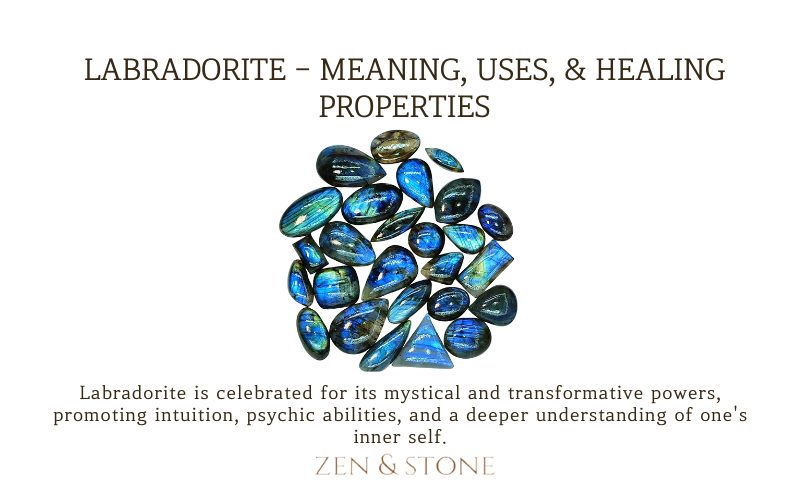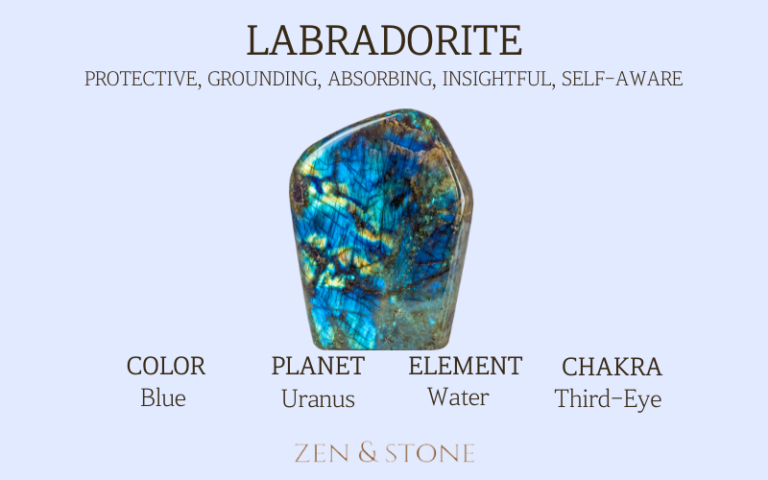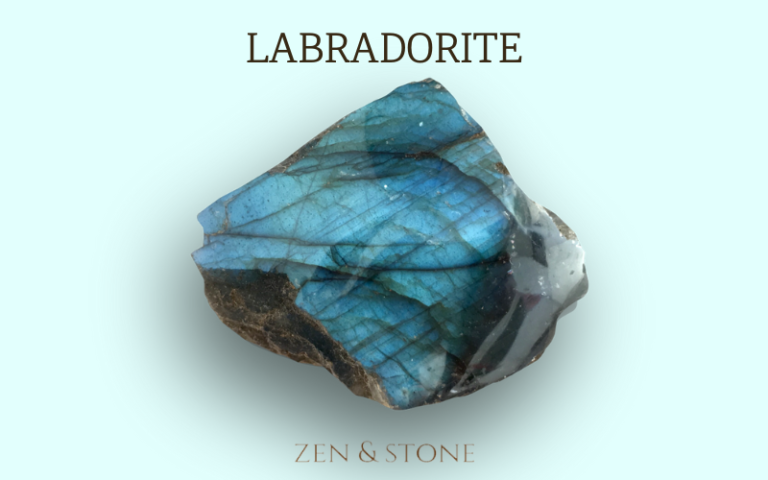
31 Oct Labradorite – Meaning, Uses, & Healing Properties
Labradorite crystal is a beautiful, iridescent stone that has captured the attention of many crystal enthusiasts. It is a type of feldspar mineral that is known for its unique flashes of color that can range from blue and green to orange and red. This stunning crystal is believed to have powerful healing and metaphysical properties that can help activate one’s inner power and potential.
Originating from the Canadian province of Labrador, this crystal has a rich history that dates back to the native Inuit people who believed it to be a stone of magic and protection. Today, it is widely used in spiritual and energy work to help balance the chakras and connect with higher levels of consciousness. With its unique beauty and powerful properties, it’s no wonder that Labradorite crystal has become a popular choice for those seeking to enhance their spiritual practice.
Key Takeaways
- Labradorite crystal is a feldspar mineral known for its iridescent flashes of color.
- It has a rich history dating back to the native Inuit people, who believed it to be a stone of magic and protection.
- Labradorite crystal has powerful healing and metaphysical properties that can help balance the chakras and connect with higher levels of consciousness.
Origin and History of Labradorite Crystal
Labradorite is a mineral that belongs to the plagioclase feldspar group. It was first discovered on the Isle of Paul near the Labrador Peninsula in Canada in 1770 by Moravian missionaries. The mineral was named after the location where it was found.
However, Labradorite has been known to the indigenous Inuit people for centuries before its discovery by the missionaries. Inuit legends say that the Northern Lights were once trapped inside the rocks along the coast of Labrador. A warrior struck the rocks with his spear, releasing the lights and creating the beautiful stone we now know as Labradorite.
Labradorite has been used by the Inuit people for both practical and spiritual purposes. They believed that the stone had the power to attract good luck, protect against negativity, and enhance intuition. Labradorite was also used as a decorative item in their clothing and jewelry.
In the late 18th and early 19th centuries, Labradorite became popular in Europe as a gemstone. It was used in jewelry, decorative objects, and even in architectural designs. Today, Labradorite is still highly valued for its unique iridescent properties and is used in a variety of ways, including in jewelry, sculptures, and crystal healing.
Physical Properties
Labradorite is a feldspar mineral that is part of the plagioclase series. It is typically gray-green, dark gray, black, or grayish-white in color, with iridescent flashes of blue, green, yellow, and red when viewed from certain angles.
Here are some of the physical properties of Labradorite Crystal:
- Hardness: Labradorite has a hardness of 6 to 6.5 on the Mohs scale, which makes it a relatively hard mineral.
- Luster: It has a vitreous to pearly luster, which gives it a shiny and reflective appearance.
- Transparency: Labradorite is typically opaque, but some specimens may be translucent to transparent.
- Cleavage: It has two cleavage planes that intersect at an angle of about 86 degrees, which makes it relatively easy to cleave.
- Density: The density of Labradorite is about 2.68 to 2.72 g/cm3, which is similar to that of other feldspar minerals.

Types of Labradorite Crystal
Labradorite is a calcium-rich feldspar mineral that is known for its unique play of colors, also known as labradorescence. There are several types of labradorite crystals, each with their own distinct characteristics and properties.
Spectrolite
Spectrolite is a rare variety of labradorite that is found in Finland. It is known for its intense and vibrant colors, which range from deep blues and greens to fiery oranges and reds. Spectrolite is believed to be a powerful stone for enhancing intuition and spiritual awareness, as well as promoting emotional healing and balance.
Rainbow Moonstone
Rainbow Moonstone is a type of labradorite that is found in India and other parts of the world. It is characterized by its milky white color and iridescent flashes of blue, green, and pink. Rainbow Moonstone is often associated with the feminine energy of the moon and is believed to have a calming and soothing effect on the emotions.
Andesine Labradorite
Andesine Labradorite is a type of labradorite that is found in the Andes Mountains of South America. It is known for its warm and earthy colors, which range from golden yellows and oranges to deep reds and browns. Andesine Labradorite is believed to be a powerful stone for grounding and stabilizing energy, as well as promoting courage and inner strength.
Moreover, each type of labradorite crystal has its own unique properties and characteristics that make it a valuable addition to any crystal collection. Whether you are looking to enhance your intuition, promote emotional healing, or ground your energy, there is a type of labradorite crystal that can help you achieve your goals.
Healing and Metaphysical Properties
Black obsidian is a powerful crystal that has been used for centuries for various
Labradorite is a powerful crystal that is believed to have a range of healing and metaphysical properties. Here are some of the ways in which this crystal can be used for healing and spiritual growth.
Emotional Healing
Labradorite is said to be a helpful crystal for those who are struggling with anxiety, depression, or other emotional issues. It is believed to help calm the mind and promote feelings of peace and serenity. This crystal is also thought to be helpful for those who are going through difficult transitions or changes in their lives.
Physical Healing
In terms of physical healing, Labradorite is believed to have a range of benefits. It is said to be helpful for those who are dealing with issues related to the respiratory system, such as asthma or bronchitis. This crystal is also believed to be helpful for those who are dealing with issues related to the digestive system, such as irritable bowel syndrome or acid reflux.
Spiritual Healing
Labradorite is considered to be a powerful crystal for spiritual growth and development. It is believed to help open the third eye chakra, which is associated with intuition and psychic abilities. This crystal is also thought to be helpful for those who are looking to connect with their higher selves or with spiritual guides and angels.
purposes. Here are some of the most common uses of black obsidian:
Jewelry
Black obsidian is a popular choice for jewelry due to its beautiful, glossy appearance. It is often used to make necklaces, bracelets, and earrings. Wearing black obsidian jewelry is believed to provide protection against negative energy and promote emotional healing.
Home Decor
Black obsidian is also commonly used in home decor. It can be used as a decorative piece or incorporated into furniture, such as table tops or countertops. Its sleek black appearance adds a touch of elegance to any room. Additionally, placing black obsidian in a room is believed to provide protection against negative energy and promote a peaceful environment.
Meditation
Black obsidian is a popular crystal for meditation due to its grounding and protective properties. Meditating with black obsidian is believed to help release negative energy and promote emotional healing. It can also help with mental clarity and focus during meditation.
Black obsidian is a versatile crystal with a range of uses. Whether used for jewelry, home decor, or meditation, black obsidian is a powerful tool for promoting emotional healing and protecting against negative energy.
How to Use Labradorite Stone
Labradorite stone is a versatile crystal that can be used in many different ways to enhance its healing properties. Here are some tips on how to use Labradorite crystal:
Meditation: Hold a piece of Labradorite in your receiving (non-dominant) hand during meditation to help quiet your mind and connect with your inner self. The crystal’s energy can help you access deeper levels of consciousness and spiritual insight.
Wearing: Wearing Labradorite as jewelry, such as a pendant or bracelet, can help you keep its healing properties close to your body throughout the day. This can help you stay centered, calm, and focused, even during stressful situations.
Placing: Place a piece of Labradorite on your desk, nightstand, or other areas where you spend a lot of time to help create a peaceful, harmonious environment. The crystal’s energy can help clear negative energy and promote positive vibrations.
Chakra Healing: Place a piece of Labradorite on your throat chakra during meditation or energy healing sessions to help balance and activate this energy center. The crystal’s energy can help you express your truth and communicate clearly and effectively.
Visualization: Hold a piece of Labradorite while visualizing your goals and intentions to help amplify your manifestation power. The crystal’s energy can help you tap into your inner strength and manifest your dreams into reality.
- Remember to cleanse and recharge your Labradorite crystal regularly to keep its energy clear and strong. You can do this by placing it in sunlight or moonlight, smudging it with sage or palo santo, or using other cleansing methods that resonate with you.

How to Cleanse and Charge Labradorite Crystal
Labradorite is a beautiful and powerful crystal that can help you with your spiritual journey. However, to keep it working at its best, it’s important to cleanse and charge it regularly. Here are some methods you can use:
Cleansing Methods
- Moonlight: Place your labradorite under the light of the full moon for at least 4 hours. This method is gentle and effective.
- Sunlight: You can also cleanse your labradorite by placing it under the sun for a few hours. However, be careful not to leave it for too long, as prolonged exposure to sunlight can cause fading.
- Water: You can cleanse your labradorite by placing it under running water for a few minutes. Make sure the water is not too hot or too cold, as extreme temperatures can damage the crystal.
- Amethyst Geode: Another effective method is to place your labradorite inside an amethyst geode for at least 24 hours. This will help to remove any negative energy and recharge the crystal.
Charging Methods
- Moonlight: You can also charge your labradorite by placing it under the light of the full moon for at least 4 hours. This will help to amplify its energy and power.
- Sunlight: Placing your labradorite under the sun for a few hours can also help to charge it. However, be careful not to leave it for too long, as prolonged exposure to sunlight can cause fading.
- Earth: You can also charge your labradorite by burying it in the earth for a few days. This method is particularly effective if you want to connect with the grounding energy of the earth.
Remember to cleanse and charge your labradorite regularly to keep it working at its best.
Conclusion
Labradorite is a fascinating gemstone with a rich history and enduring fascination. Its intriguing colors, associations with the magical northern lights, and transformative properties make it a beloved crystal for those seeking knowledge, spiritual growth, and a connection to their subconscious mind.
This stone is believed to deflect bad vibes and help the wearer remain grounded and centered. It is ideal to keep on or around your person if you are involved in psychic work or any other form of metaphysical studies. Labradorite is also known to promote personal growth and access higher realms of consciousness.
In addition, this crystal has physical healing properties. It assists in reducing anti-social, reckless, or impulsive behavior in children, teenagers, and adults who are easily led into trouble by others. Labradorite may also aid in detoxifying the effects of tobacco, alcohol, and to a lesser degree, hard drugs.

Sorry, the comment form is closed at this time.